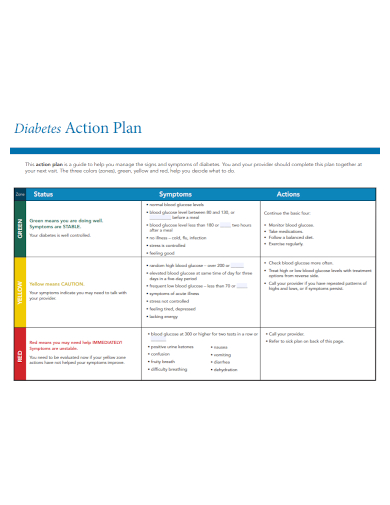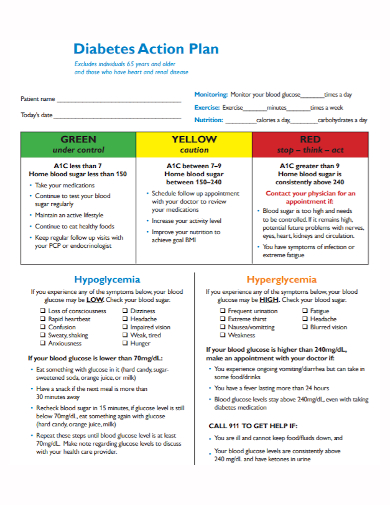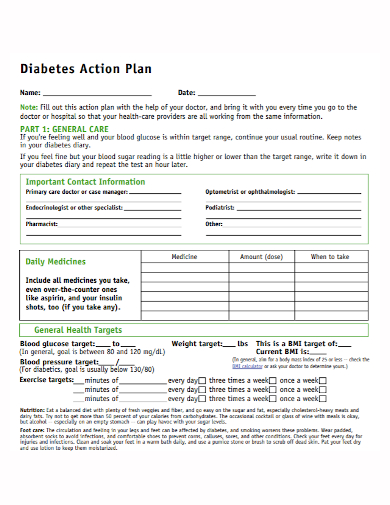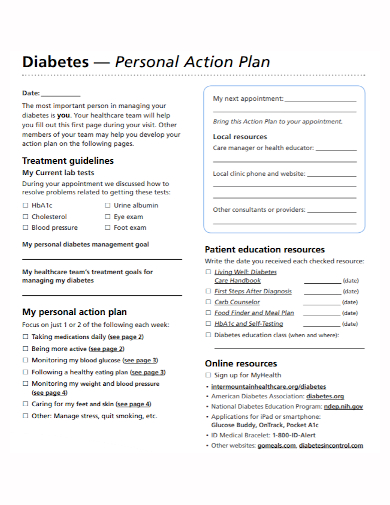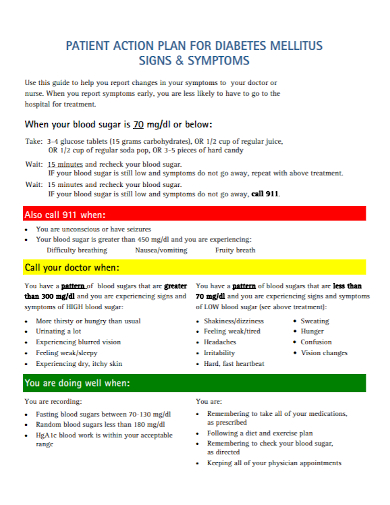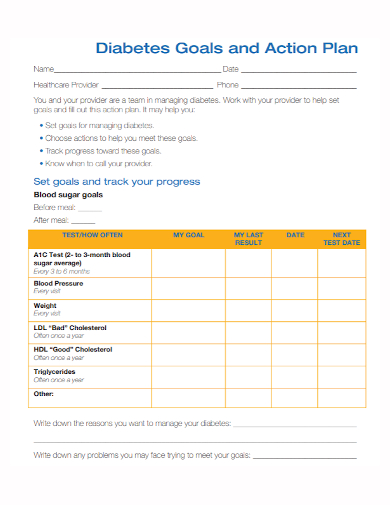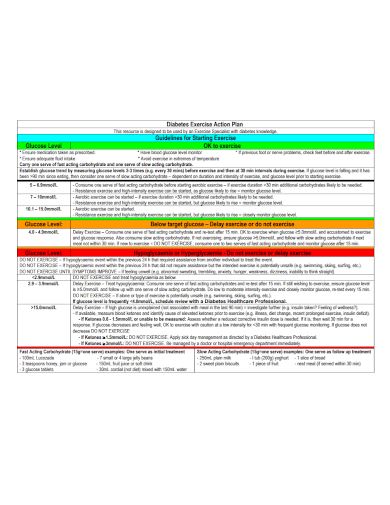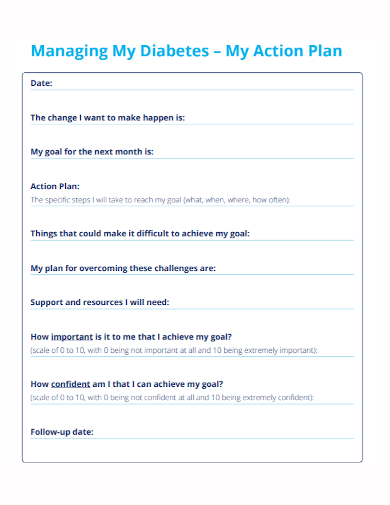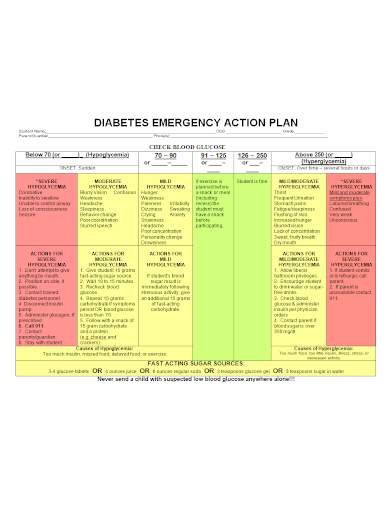More over 34 million people (about 1 in 10) have diabetes, with 90-95 percent of them having type 2 diabetes. Type 2 diabetes is most common in persons over 45, but it is now affecting an increasing number of adolescents, teenagers, and young adults. The major causes of diabetes are assaults and destruction of insulin-producing cells in the pancreas by your immune system, which usually battles dangerous germs or viruses. You will have very little or no insulin as a result of this. Diabetes can affect your daily living, as such, you need to have a plan in place to properly manage and treat your disease. Look no further! In this article, we provide you with free and ready-to-use samples of Diabetes Action Plans that you could use for preventive and emergency use for your convenience. Keep on reading to find out more!
10+ Diabetes Action Plan Samples
1. Diabetes Action Plan Template

2. Diabetes Action Plan
3. Sample Diabetes Action Plan
4. Diabetes Care Action Plan
5. Diabetes Personal Action Plan
6. Diabetes Patient Action Plan
7. Diabetes Management Action Plan
8. Diabetes Goals Action Plan
9. Diabetes Exercise Action Plan
10. Individual Diabetes Action Plan
11. Diabetes Emergency Action Plan
What Is a Diabetes Action Plan?
A Diabetes Action Plan is a step-by-step approach to managing diabetes symptoms and indications. The plan should tell schools when a kid requires monitoring or assistance with important tasks, such as testing glucose levels or taking insulin at school. It’s an important document that explains how schools may help kids with type 1 diabetes learn and participate fully in school.
The plan is generally prepared in conjunction with the student, their parents or caregivers, by the student’s clinical treatment team. The plan will detail a student’s type 1 diabetes monitoring, insulin, and daily management requirements while at school. The plan should tell schools when a kid requires monitoring or assistance with important tasks, such as testing glucose levels or taking insulin at school.
How to Make a Diabetes Action Plan
A diabetic action plan outlines what you must do to maintain your health. It outlines the services and resources you’ll need to maintain a healthy lifestyle. A Diabetes Action plan template helps provide the framework you need to ensure that you have a well-written and thorough plan. You can choose one of our excellent templates listed above so that you don’t have to go through the process of drafting one from scratch. Should you want to write one yourself, follow these tips below to guide you:
1. Set SMART objectives.
What are the goals, and how will the patient achieve them? The nurse will respond to these questions based on the patient’s input, the evaluation, and the nursing diagnosis. The nurse and the patient work together to create acceptable goals that can be met with nursing interventions and the patient’s own effort. Short-term and long-term goals are both possible.
2. Examine the patient.
Medical history, lab findings, vital signs, head-to-toe assessment data, talks with the patient and their loved ones, observations from other care team members, and demographic information are all included.
3. Implement treatment interventions.
Interventions are actions taken by the healthcare worker to help the patient achieve their goals and achieve the desired outcomes, such as administering medications, educating the patient, checking vital signs every couple of hours, implementing fall prevention measures, or assessing the patient’s pain levels at regular intervals. The nurse also notes care when they execute interventions, such as dependent nursing interventions requested by physicians, in this area.
FAQs
What can schools do to assist diabetics?
Schools can devise a strategy to assist children in managing their diabetes and dealing with any diabetes-related crises. Create a Diabetes Medical Management Plan with a child’s parents, doctor, and school personnel, including information on services the school will give and how to identify high and low blood sugar levels.
Is diabetes a regular occurrence at school?
In school-aged children, diabetes is a prevalent chronic illness. Diabetes-related problems, both short- and long-term, can be postponed or avoided with good treatment. Diabetes must be treated 24 hours a day, seven days a week, including during school hours.
When should diabetics put down their forks?
Mealtimes for most diabetics should be spread out throughout the day as follows; breakfast should be consumed within an hour and a half after waking up. After that, eat every 4 to 5 hours. If you become hungry in between meals, have a snack.
Failure to regulate diabetes over time can harm vital organs such as the heart, kidneys, eyes, and nerves. This implies that persons with diabetes are more likely to develop heart disease and stroke, as well as kidney illness, eye difficulties, and nerve disorders. As such, a diabetes action plan is important. To help you get started, download our easily customizable and comprehensive samples of Diabetes Action Plan today!
Related Posts
FREE 10+ Manufacturing Corrective Action Plan Samples in MS Word | Google Docs | Apple Pages | PDF
FREE 10+ Project Corrective Action Plan Samples in MS Word | Google Docs | Apple Pages | PDF
FREE 10+ Business Corrective Action Plan Samples in PDF
FREE 10+ Audit Corrective Action Plan Samples in MS Word | Google Docs | Apple Pages | PDF
FREE 10+ Incident Corrective Action Plan Samples in MS Word | Google Docs | Apple Pages PDF
FREE 10+ Remediation Action Plan Samples in MS Word | Google Docs | Apple Pages | PDF
FREE 10+ Assessment Action Plan Samples in MS Word | Google Docs | PDF
FREE 10+ Workplace Emergency Action Plan Samples in MS Word | Google Docs | Apple Pages | PDF
FREE 10+ Business Emergency Action Plan Samples in MS Word | Google Docs | Apple Pages | PDF
FREE 10+ School Emergency Action Plan Samples in MS Word | Google Docs | Apple Pages | PDF
FREE 10+ Event Emergency Action Plan Samples in MS Word | Google Docs | Apple Pages | PDF
FREE 10+ Church Emergency Action Plan Samples in MS Word | Google Docs | Apple Pages | PDF
FREE 10+ Recruitment Action Plan Samples in MS Word | Google Docs | Apple Pages | PDF
FREE 10+ Earthquake Action Plan Samples in MS Word | Google Docs | Apple Pages | PDF
FREE 10+ Disciplinary Action Plan Samples [ Progressive, Corrective, Student ]

